A weekend in Bremen, Germany
My husband and I spent a weekend in Bremen, Germany, which is about a two-hour trip from home, several years ago. Then I visited again for just a couple of days in 2025. Here are some suggestions if you plan to spend a few days or a weekend in Bremen. There’s certainly enough to do to spend more time there though!
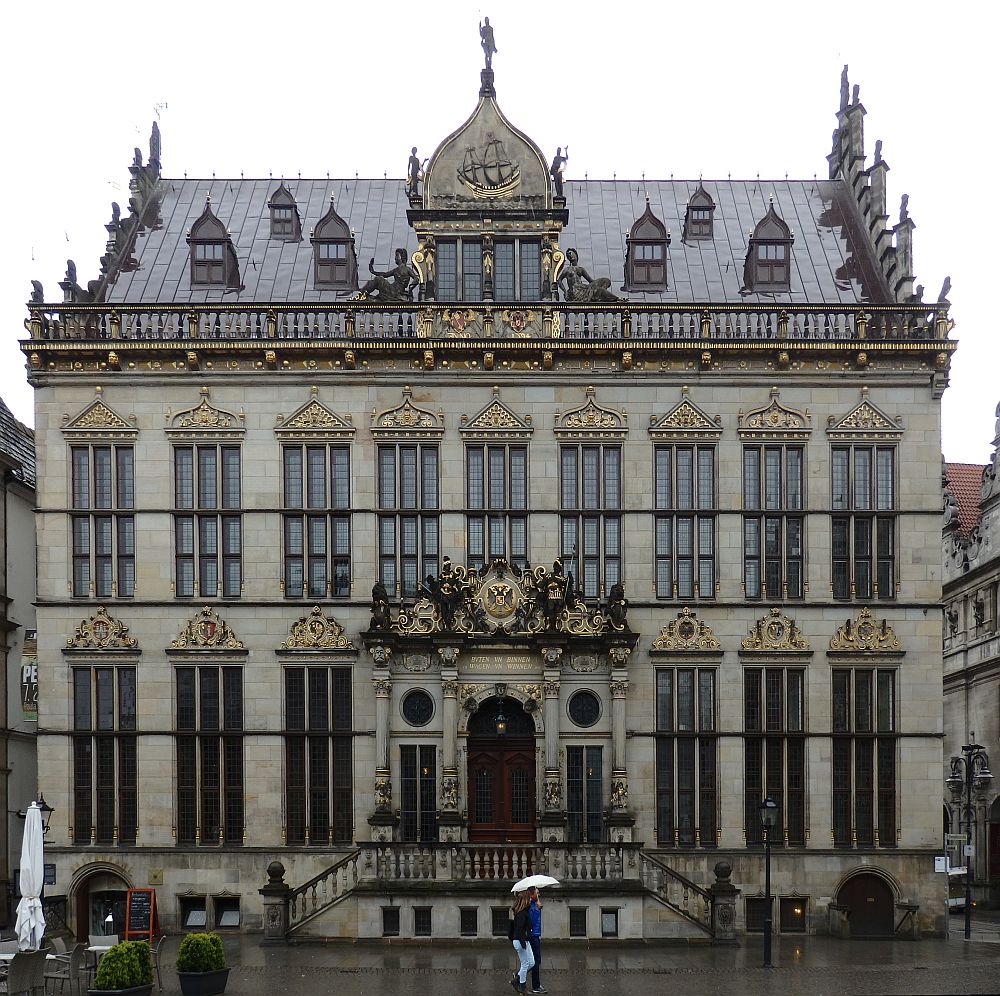
[Last updated November 10, 2025]
On that first visit, we didn’t choose Bremen because of anything in particular except that we wanted a weekend away, and we also felt we needed to be close enough to get home quickly if anything went wrong with the three teenagers we were leaving behind. At least I wanted to be close; my husband didn’t agree that it was necessary.
In late October 2025, I returned for a quick press trip sponsored by the Bremen tourism board. While I originally wrote this article after my visit with my husband, I added to it after the recent trip.
Disclosure: This article contains affiliate links. If you click on one and make a purchase, I will receive a small commission. This will not affect your price. Privacy policy.
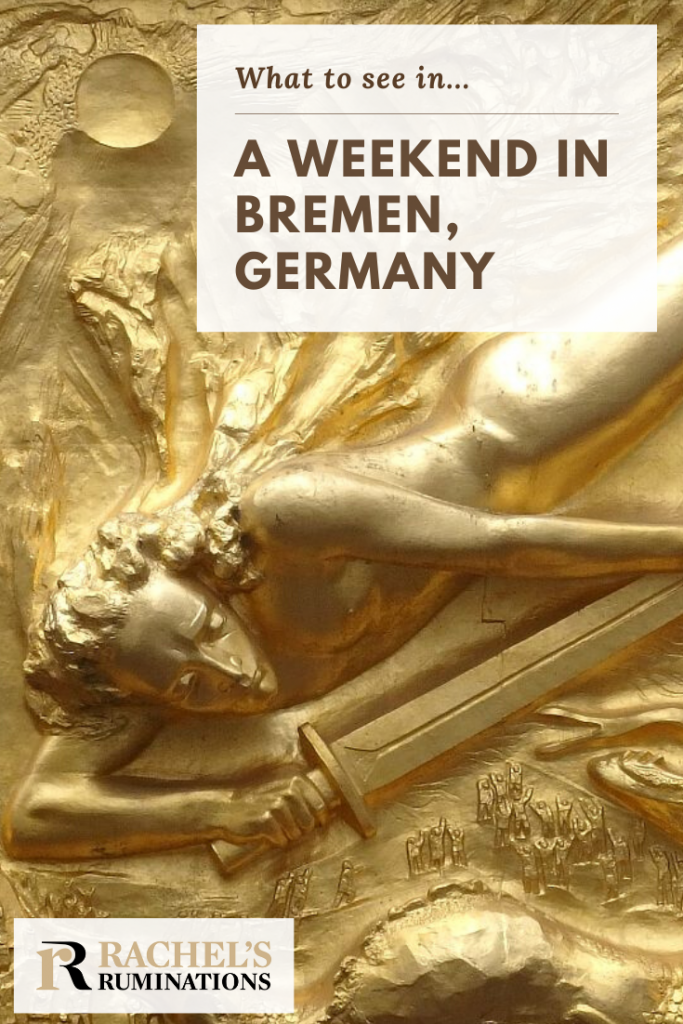
Bremen Altstadt
The main tourist draws in Bremen are in the Altstadt (old city) area. Dominated by St Petri Dom cathedral, the market square at the center of town is home to a number of lovely buildings from the period when Bremen owed its prosperity to being a Hanseatic League member. Its Merchants’ Guild joined the league – an international free trade agreement – in 1358.
St. Petri Dom
The Cathedral is worth going inside. There is plenty to see: besides the decorative work and architecture of the interior, the museum – also inside – has various items found during excavations. And the view from the top of one of the towers is worth the climb. See my separate article about the cathedral.
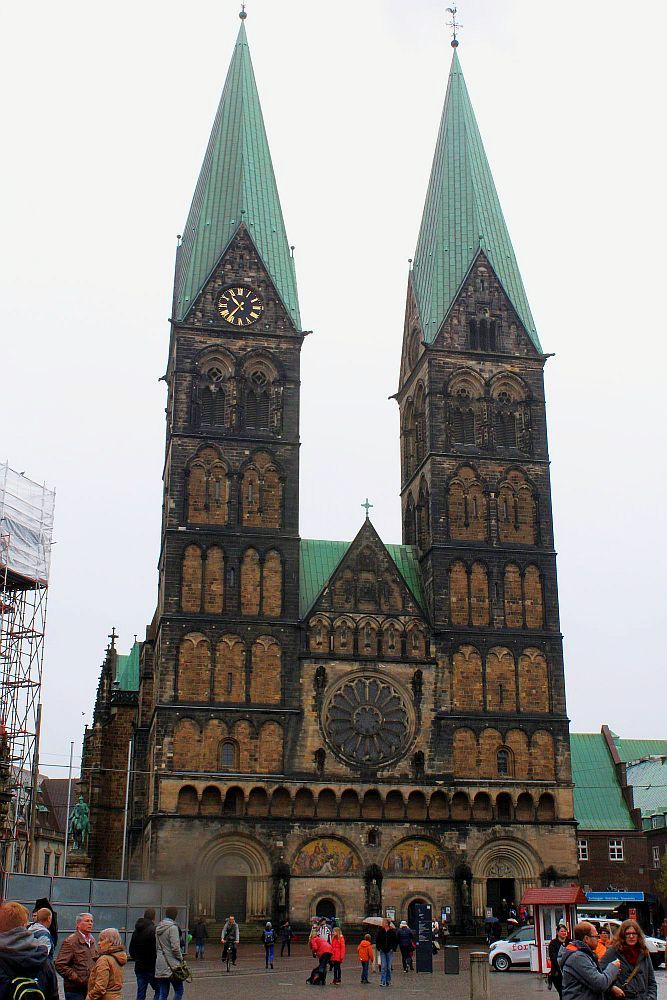
If you’re interested in Hanseatic League history, here are some other articles about Hanseatic cities:
- A Riga city tour: 10+ things to see in Riga
- A maritime-themed weekend in Hamburg
- Boat Bike Tours: A review of “Hansa Highlights” (a one-week trip in the Netherlands visiting a whole list of Hanseatic towns)
The Rathaus
The Rathaus is the old city hall, and, together with the Roland statue in front of it, is a UNESCO World Heritage Site. It was built in the early 15th century and renovated in Renaissance style in the 17th century. It’s one of few monuments in Bremen that survived World War II virtually unscathed. The ornamentation on the exterior is intricate and worth some study. Tours are offered of the inside.
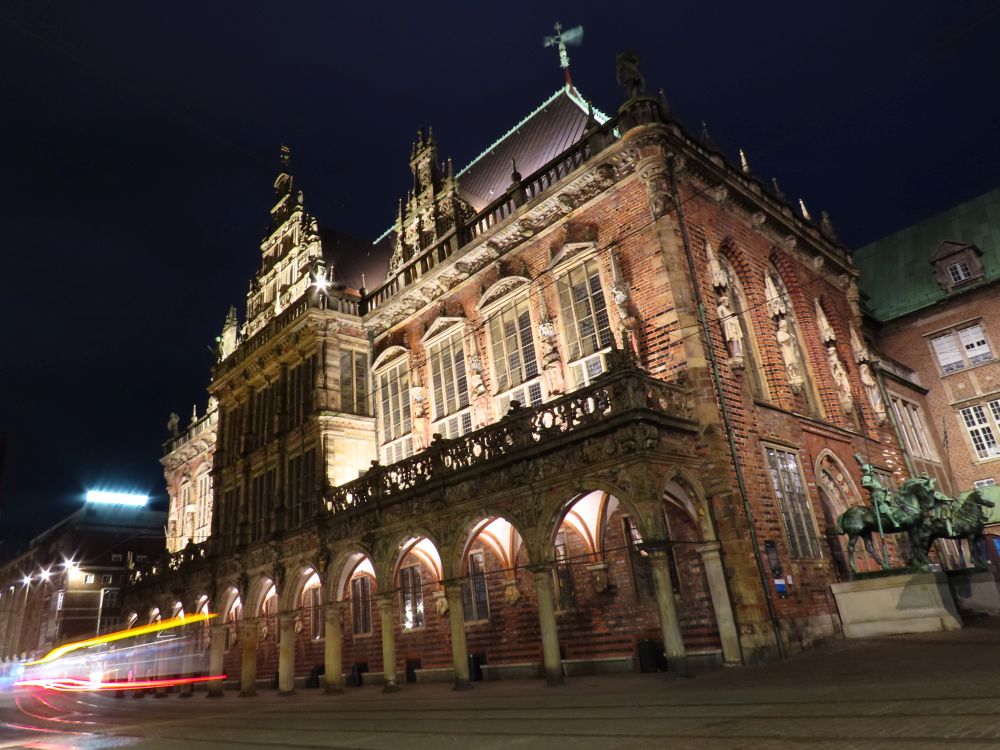
Rathaus Bremen: Am Markt 21. Can only be visited on a tour. One-hour tours in English daily at noon, or arrange one for your group via Bremen Tourismus. Tours in German: Monday-Saturday at 11:00, 12:00, 15:00 and 16:00. Tour price: adults €9.50; children 13-17 €5. Book an English tour here.
Ratskeller
The basement of the Rathaus has its own special history. Since Bremen was such an important trade city, the basement became a wine cellar: the Ratskeller. Today, it is still home to a wine merchant as well as a restaurant, both called Ratskeller.
You can take a tour of the wine cellar. The shortest is a straightforward one-hour tour. Longer tours offer various amounts of wine tasting, some paired with chocolate.
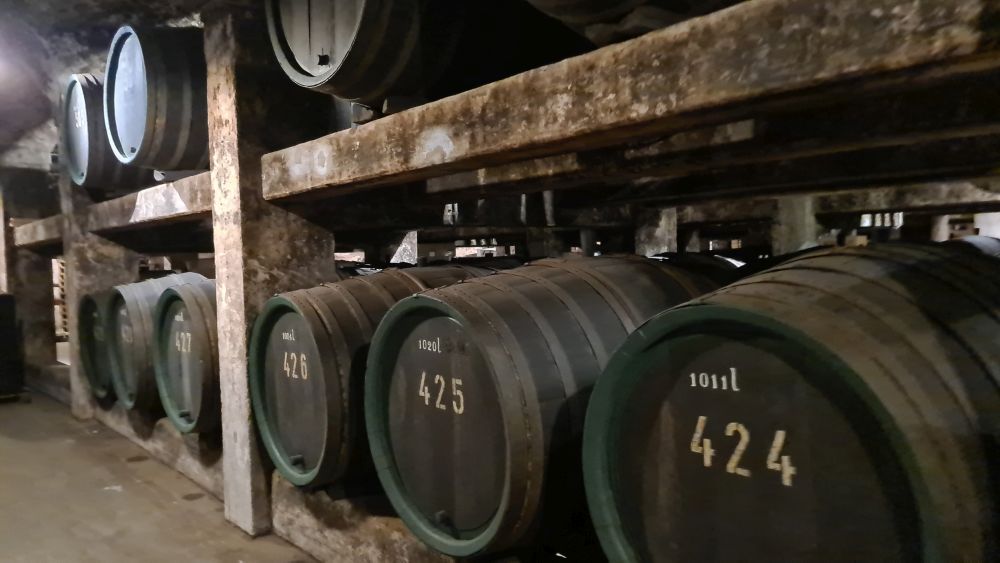
Ratskeller (wine merchant): Tours are only at set times and dates, and it’s not clear when they are in English. Contact them at kellerfuehrung@ratskeller.de or call +49 421 – 33 77 88. Look up the different kinds of tours here (Use a translation program.).
In the restaurant, besides enjoying traditional Bremen food, you can see some massive wine barrels, each carved with ornate figures.
Roland statue
The Roland statue in front of the Rathaus is over nine meters (almost 30 feet) tall (over ten meters if you count the column above his head). The largest of perhaps 30 such statues in Germany, it’s also the oldest, dating to 1404.
Roland, apparently, is a symbol of market rights and freedoms, so again it’s linked to Bremen’s membership in the Hanseatic League, but also to Bremen’s status as an independent city. Roland wears armor and carries a shield, symbolically defending the city. He faces the cathedral; this was intentional because of the tension between the city as a self-governing entity and the claims of the church as the highest authority over the city.
Roland’s story dates from the 9th century, when he was a commander in the Frankish army led by Charlemagne. Charlemagne led the Franks and several other forces to Spain to extend his own dominion and spread Christianity among the “heathens” as well.
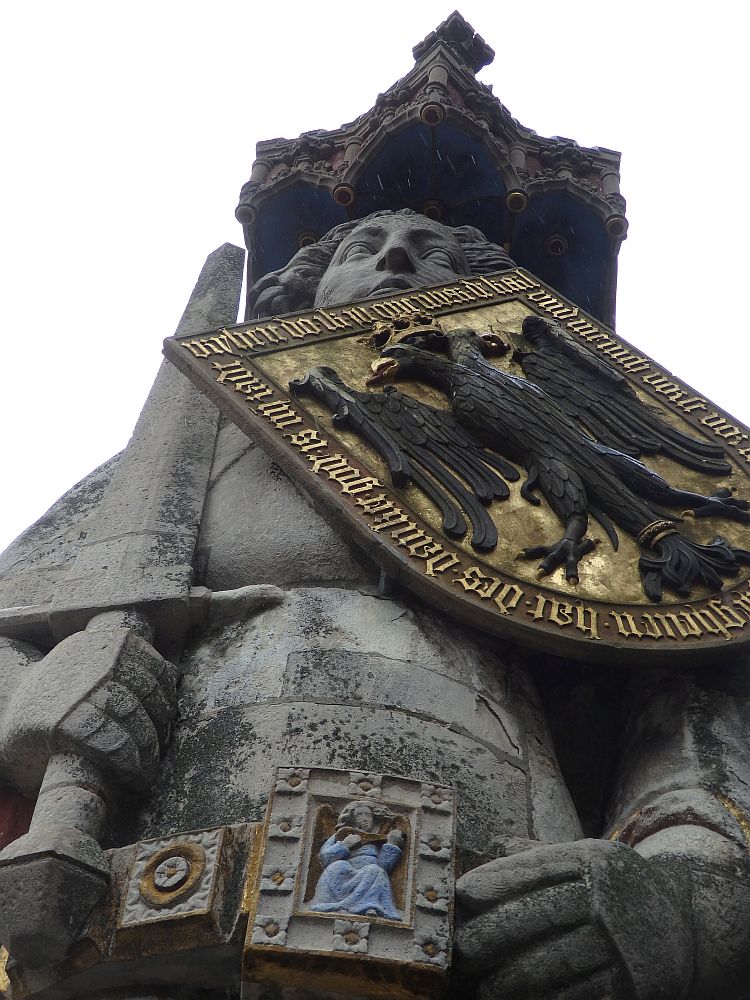
Arriving in Basque country, Charlemagne ordered the destruction of the Basque capital Iruña, now called Pamplona. He believed the Basques supported the Moors. As the army headed back toward France, Roland was part of the rearguard. The Basques, furious about the destruction of their city, attacked. The entire rearguard was killed, including Roland.
Roland would never have been famous, however, if it hadn’t been for an epic poem written in the 11th century. It portrayed Roland as a hero, defending the honor of Christianity against the Muslims. It completely ignored the fact that the Basques weren’t Muslims.
This is why the Roland statue wears a coat of armor and carries a sword and shield – it defends the city as well as Christianity. The angel and rose on Roland’s belt are symbols of heroes fighting for Christianity. Under his feet at the base of the statue is a face that represents Frisian pirates, something else the city had to defend itself against. The points attached to the figure’s knees represent the “Bremer ell,” the distance between elbow and fingertips. It was used as a measure for lengths of cloth and other products in the marketplace.
The Town Musicians of Bremen
Another famous Bremen statue stands next to the Rathaus; it depicts a donkey with a dog, a cat and a rooster on its back, illustrating a Grimm fairy tale called “The Town Musicians of Bremen.” I wrote about the statue and the story in this article.
A row of buildings nearby on Marktplatz is an indication of what much of the Altstadt must have looked like before World War II. They aren’t as old as they look, however. Some pre-date the war, but are early 20th-century designs or reconstructions of older buildings.
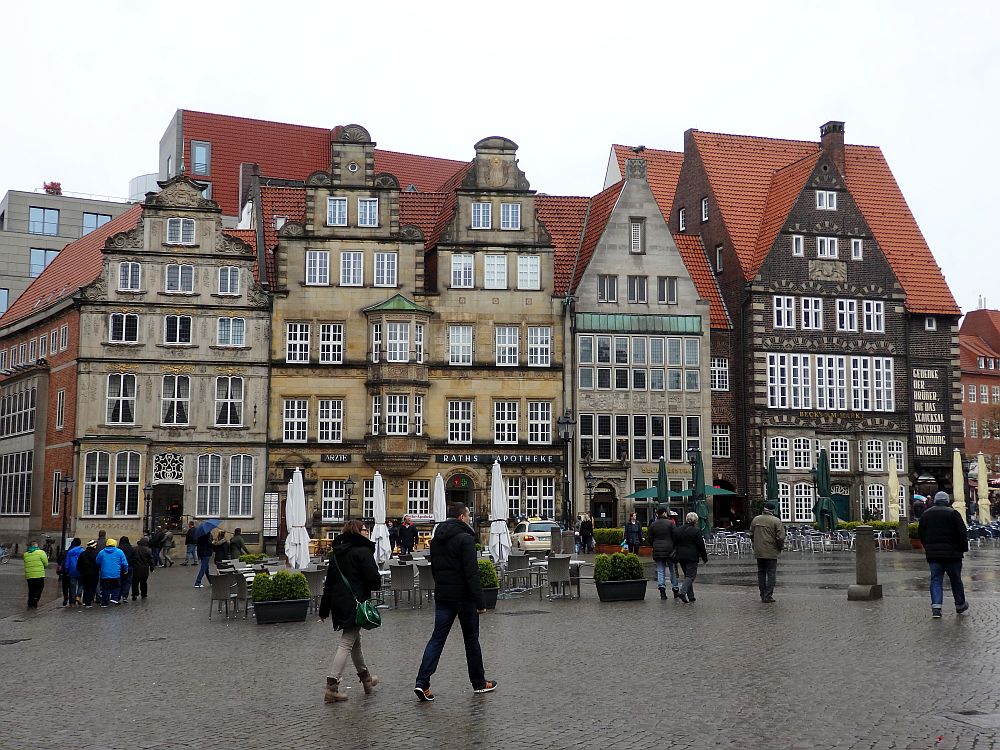
Böttcherstraße
Böttcherstraße means “street of the coopers.” When ships used to come right up to the city on the Weser river, merchants bought barrels from coopers here, rolling them to the ships moored nearby. The street lost this purpose once the city built Bremerhaven – a new, bigger harbor 65 kilometers (40 miles) away.
In the interwar period, the wealthy coffee trader Ludwig Roselius decided to redevelop the street, so most of the buildings on this very short street date to 1922-1931.
Lichtbringer
Atop the entrance to the street hangs a shining bas-relief called Lichtbringer (Bringer of Light), depicting the archangel Michael battling the forces of evil. Really, though, it was meant as an allegory, representing Hitler himself defeating the Weimar Republic, with the sun of the new Reich rising in the top left. Roselius commissioned the work of art to show his loyalty to Hitler and the Nazi party. According to Wikipedia, Hitler nevertheless rejected it as “degenerate.”
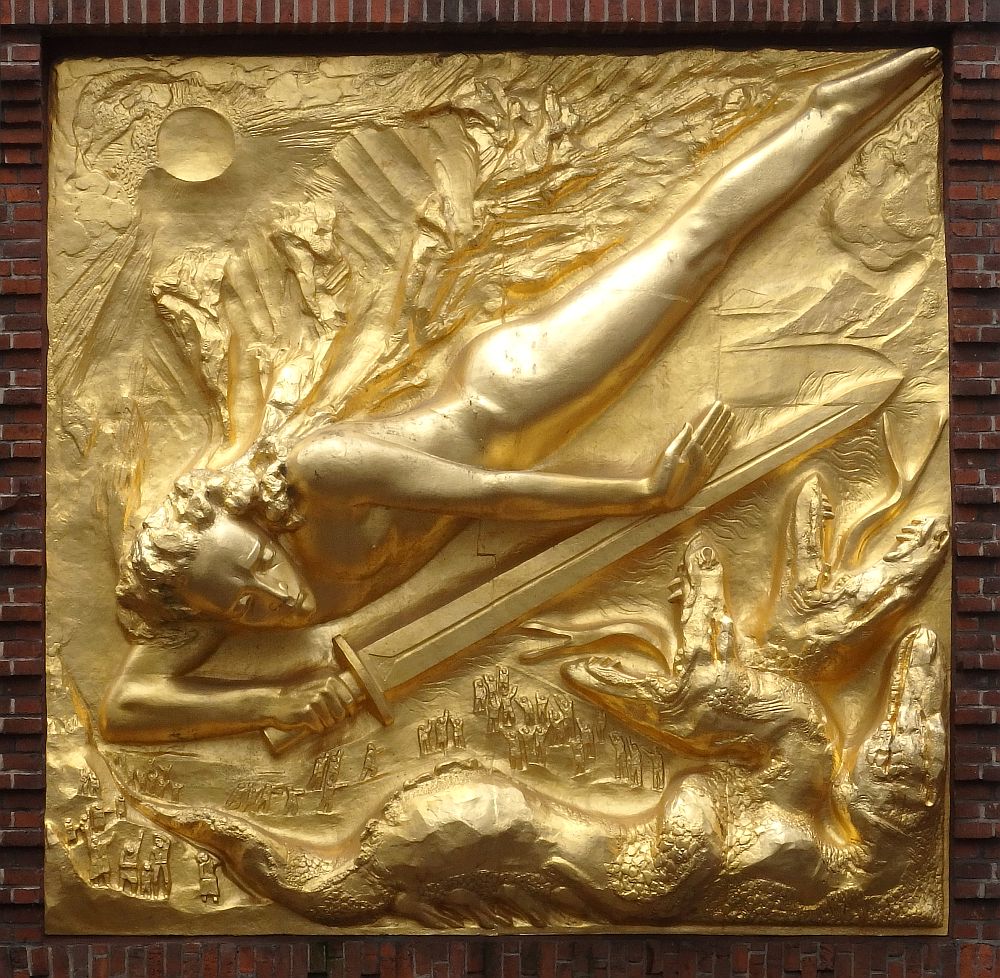
Ludwig Roselius Museum
A stroll down Böttcherstraße shows some interesting architectural contrasts. The 1920s-era expressionist-style buildings (Hitler did not like those either.) were restored after bombing in the war. One building, though, was built in 1588 and is now the Ludwig Roselius Museum. I haven’t been inside, but it houses Roselius’s personal art collection.
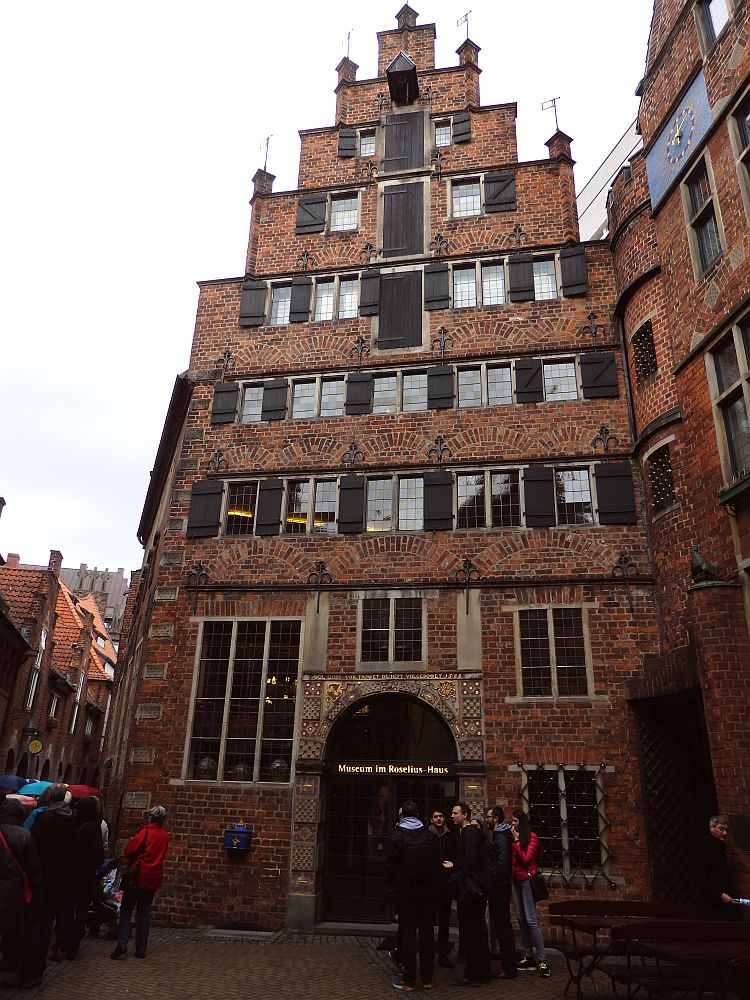
Paula Modersohn-Becker Museum
The flowing organic shapes of the expressionist buildings seemed to me attractive and playful, and respectful of Roselius’s older building in their midst. One of these newer buildings (1926) is home to the Paula Modersohn-Becker Museum, named after the artist it exhibits.
Ludwig Roselius Museum and Paula Modersohn-Becker Museum: Böttcherstraße 6–10. Open Tuesday-Sunday 11:00-18:00. Admission: €10; children under 18 free. Website.
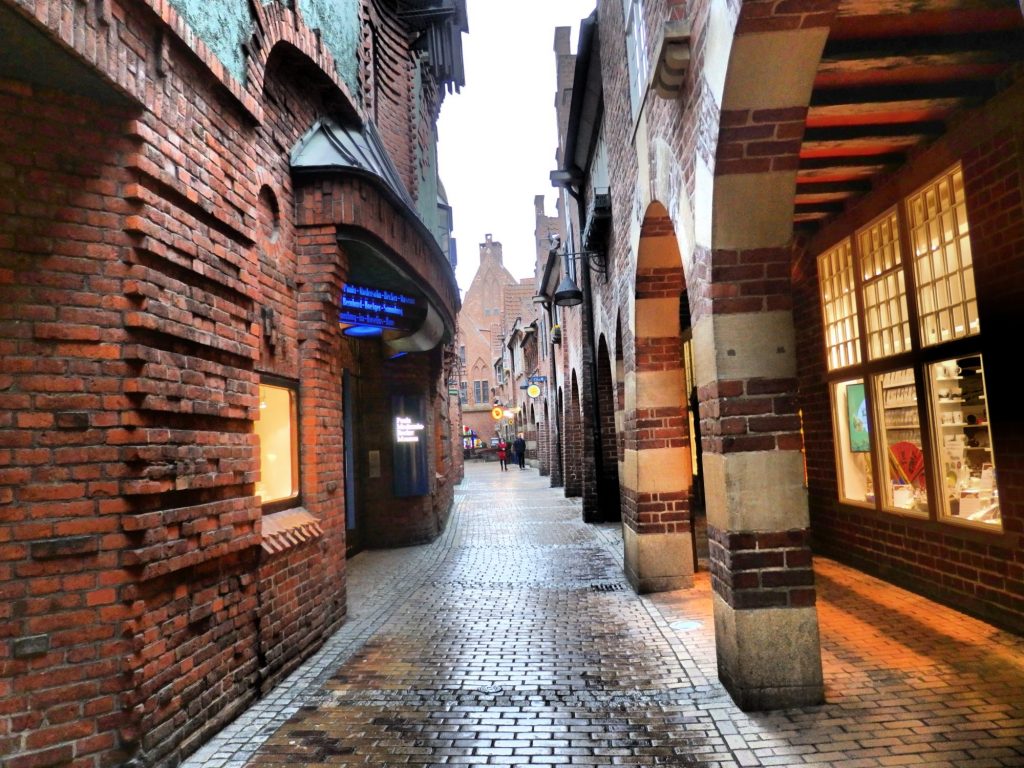
The Glockenspiel House
On the same street is the Glockenspiel House. Notice the set of 30 Meissen porcelain bells stretched between the two gables. When the bells are played, watch for the wooden panel on the left that rotates at the same time, carved with ten relief images of famous people who crossed the Atlantic, including Columbus, Lindberg and Count Zeppelin. The two buildings are now an office building, with the tourist information office on the ground floor.
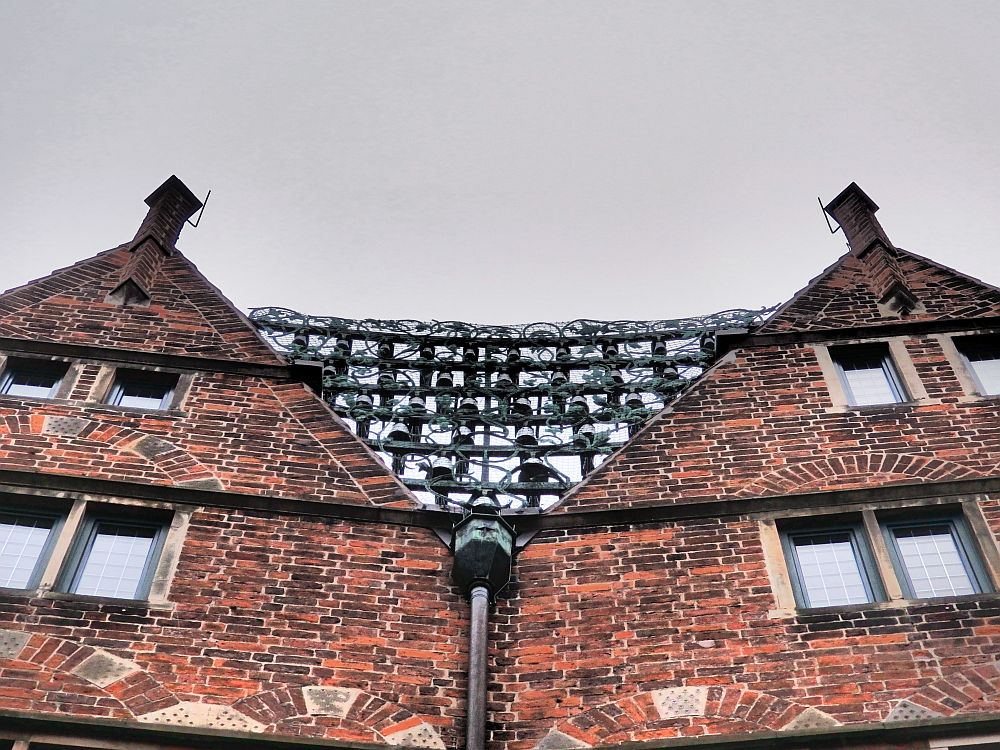
Glockenspiel House: The bells play April-December every day on the hour from 12:00 to 18:00. In January-March they play 3 times a day at 12:00, 15:00 and 18:00. However, if the temperature falls below freezing, the bells are not played because this might break the porcelain. The whole cycle of the carillon and the 10 wooden panels takes over 8 minutes.
Atlantis Haus
Atlantis Haus (1931), another of Roselius’s creations on Böttcherstraße, may look traditional on the outside, but it’s art deco on the inside. Step inside to see the elegant stairway. If you ask nicely at the desk of the Radisson Blu Hotel, connected via a hallway, they’ll give you a key to the Himmelsaal at the top of the stairway: definitely worth the climb. Its walls and floors are mosaic and its rounded roof forms a mosaic of blue and white glass panes. It has the look of an art-deco chapel, but was intended as a ballroom.
The Atlantis Haus was inspired by the idea that Atlantis sank in the North Sea, and that it held an ancient Germanic culture. This would support the Nazi views that the Germans were the oldest race and that they brought their civilization to ancient Mesopotamia and Egypt. The building was meant to house a place of research about Atlantis and has been used for a range of purposes over the years.
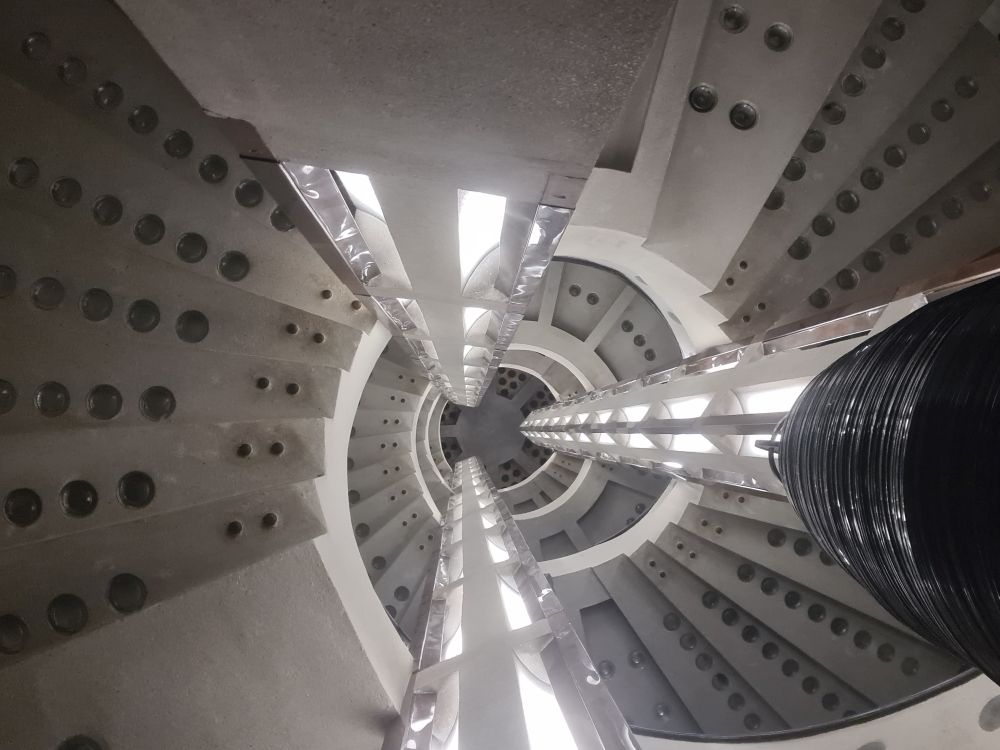
It wasn’t just the Lichtbringer bas-relief that Hitler didn’t like; he condemned all of the 1920s architecture in the street. In a 1936 speech, he rejected what he called “Böttcherstraße culture.” His local followers wanted to tear it all down. The street was saved in the end because party leaders wanted it to serve as an example of what German art and architecture should not be.
Weser River
If the weather is good, a walk along the Weser River is pleasant. On Saturdays in the warmer months a flea market takes place, which combines well with a promenade along the water. Kiosks offer food and, especially, beer to keep you going. You’ll be charged an extra euro for the glass, which you get back when you return it, but why not keep it as a souvenir?
Another option in the warmer months is to take a boat ride along the river or farther afield if the port of Bremerhaven interests you.
Book a walking tour of Bremen.
Schnoor
My favorite section of Bremen is Schnoor. This is the city’s oldest surviving district: only a couple of blocks, but lined with houses from the 15th to 18th centuries. While these were originally fishermen’s and craftsmen’s homes, nowadays it’s a pedestrian shopping district with lots of interesting little shops, galleries and cafés.
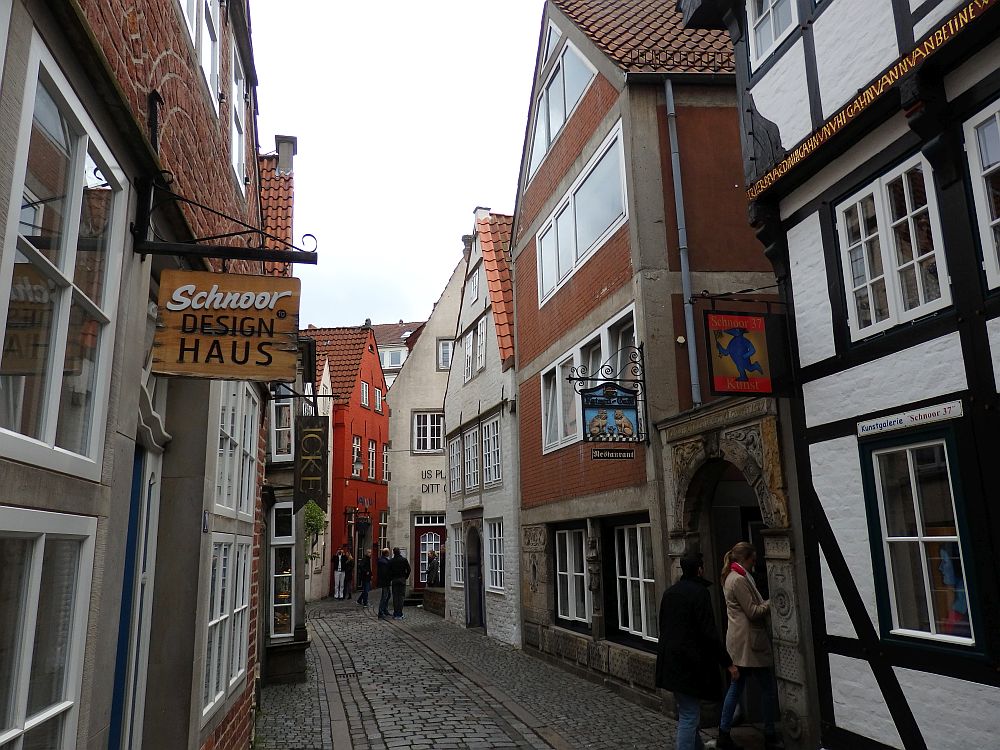
Make sure you walk down some of the little alleyways on either side. Some are very narrow but very picturesque too. And if you spot a newer building among the older ones, you’ll notice that decorative details from ruined older structures are incorporated into their facades.
The Wallanlagen in Bremen
If you look at a map of Bremen, you’ll see that the old center of town is bordered on one side by the Weser River and on the other by a zigzag-shaped canal called the Wallgraben, the old city moat.
The points of the zigzag – what remains of the old city defensive walls – have been landscaped into beautiful gardens called the Wallanlagen. We walked from the Schnoor section around the center of the city through this lovely park as far as the unexpected Muhle am Wall, a Dutch windmill. This one was built in 1898 to replace several earlier ones, but apparently the Wallanlagen had 15 windmills in the 18th century. On a sunny, warm day it would be a pleasant place to stop for a drink in the mill’s outdoor café.
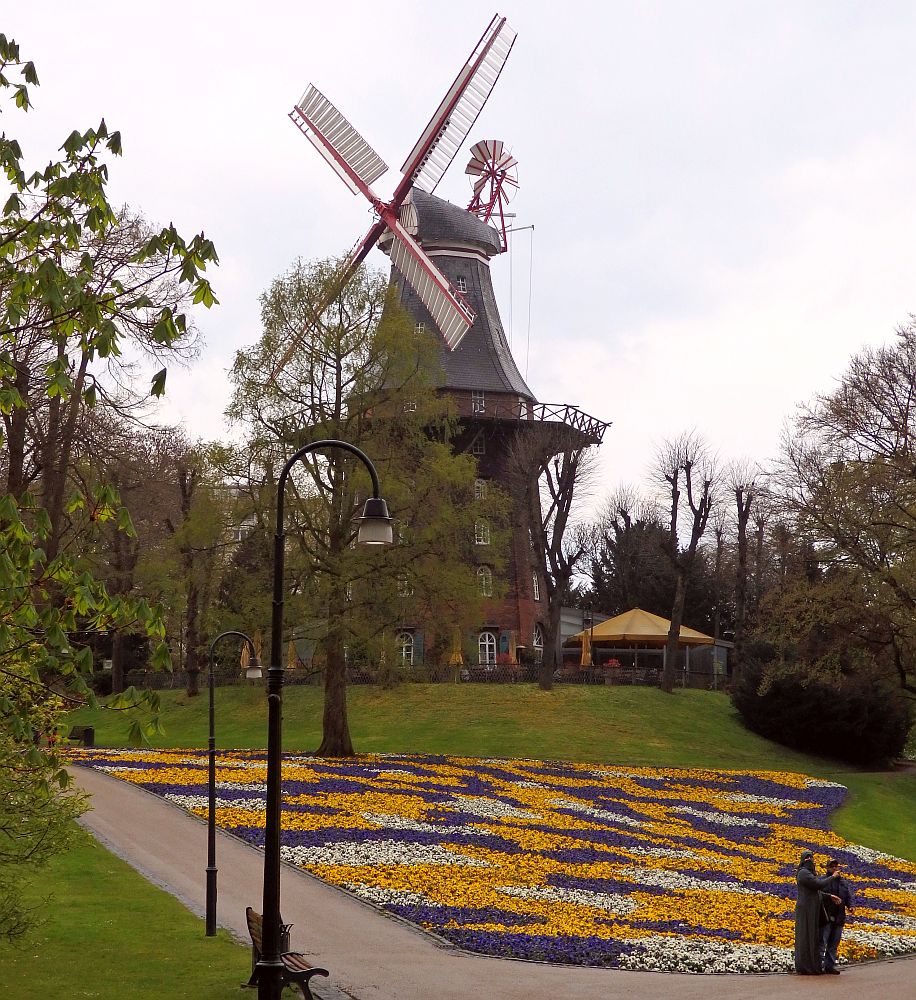
While there is certainly more to see in Bremen – several more old churches, the Bohemian Viertal section, and quite a few museums – the weekend my husband and I spent in Bremen was just enough for a little taste of the main tourist sights. Walking from sight to sight, we enjoyed ourselves, despite overcast skies and occasional rain.
And, in case you were wondering, we were happy to find that the teenagers we left at home didn’t “break the place” or cause any trouble at all!
Book your accommodations in Bremen. On my 2025 visit, I stayed at the Radisson Blu, which backs on the Atlantis Haus and the Böttcherstraße. It has a huge and bright atrium, where breakfast is very pleasant, with lots of choices. My room was comfortable and faced on the atrium, so it was insulated from any street noise.
Other museums in Bremen
Some of these museums may work together with the two mentioned in the article above to reduce pricing if you go to more than one of them in a day. Make sure to keep your ticket and ask at the next museum.
- Bremen Harbor Museum (History of Bremen as a port city). Am Speicher XI 1. Tram 3 to Waller Ring stop. Open Tuesday-Sunday 11:00-18:00. Admission: €5; children to 18 free. Website (in German).
- The Focke Museum: Bremen State Museum of Art and Cultural History (about the city’s history and general cultural history). Schwachhauser Heerstrasse 240. Take tram 4 to the Focke-Museum stop. Open Tuesday-Sunday 10:00-17:00. Admission: €6; children 18 and under free. Special exhibitions cost more. Website (only in German).
- Gerhard Marcks Haus (an art museum). Am Wall 208. Tram 2 or 3 to Theater am Goetheplatz stop. Open Tuesday-Sunday 10:00-18:00, Thursday open until 21:00. Admission: €5 but they request €10 to support the museum. Children under 18 free. Free on the first Thursday of the month. Leaflet.
- Kunsthalle Bremen (art museum). Am Wall 207. Open Tuesday 10:00-21:00 and Wednesday-Sunday 10:00-18:00, but from February 17, 2026 it will close on Wednesday-Sunday at 17:00. Admission: €18; free for children under 19. Tickets.
- Übersee-Museum (“Overseas” museum: cultures and natural history). Bahnhofsplatz 13 (opposite the central train station). Open Tuesday-Friday 9:00-17:00, Saturday-Sunday 10:00-17:00. Admission: €15; children 6-17 €7.50. There may be an extra charge for special exhibitions. Website.
- Weserburg Museum of Modern Art. Teerhof 20 (an island in the Weser river). Open Tuesday-Sunday 11:00-18:00. Admission: €12; children to 18 free. When special exhibitions are happening at the GAK Gesellschaft für Aktuelle Kunst (contemporary art), a combi-ticket is €13. Website.
- Wilhelm Wagenfeld Museum (consumer design). Am Wall 209. Take tram 2 or 3 to Theater am Goetheplatz stop. This museum only does temporary exhibitions and is closed when a new one is being set up. When it is open, hours are Tuesday 15:00-21:00 and Wednesday-Sunday 10:00-18:00. Admission: €6. Website (in German).
On my later visit, I also took a tour of Bremen’s enormous Mercedes-Benz factory. If you’re into cars, it’s something you might like.
If you’re planning to spend time in Hamburg too, take a look at these articles:
Getting to Bremen
By car, Bremen is about an hour and a half southwest of Hamburg. Compare rental car prices. Traveling by train, assuming it’s on time, will get you to Bremen from Hamburg more quickly than that.
Bremen has its own airport, with many routes within Europe. For the most part, budget airlines like Ryanair, Corendon and Eurowings use this airport.
Have you ever visited Bremen? What would you recommend doing there on a longer visit?
My travel recommendations
Planning travel
- Skyscanner is where I always start my flight searches.
- Booking.com is the company I use most for finding accommodations. If you prefer, Expedia offers more or less the same.
- Discover Cars offers an easy way to compare prices from all of the major car-rental companies in one place.
- Use Viator or GetYourGuide to find walking tours, day tours, airport pickups, city cards, tickets and whatever else you need at your destination.
- Bookmundi is great when you’re looking for a longer tour of a few days to a few weeks, private or with a group, pretty much anywhere in the world. Lots of different tour companies list their tours here, so you can comparison shop.
- GetTransfer is the place to book your airport-to-hotel transfers (and vice-versa). It’s so reassuring to have this all set up and paid for ahead of time, rather than having to make decisions after a long, tiring flight!
- Buy a GoCity Pass when you’re planning to do a lot of sightseeing on a city trip. It can save you a lot on admissions to museums and other attractions in big cities like New York and Amsterdam.
Other travel-related items
- It’s really awkward to have to rely on WIFI when you travel overseas. I’ve tried several e-sim cards, and GigSky’s e-sim was the one that was easiest to activate and use. You buy it through their app and activate it when you need it. Use the code RACHEL10 to get a 10% discount!
- Another option I just recently tried for the first time is a portable wifi modem by WifiCandy. It supports up to 8 devices and you just carry it along in your pocket or bag! If you’re traveling with a family or group, it might end up cheaper to use than an e-sim. Use the code RACHELSRUMINATIONS for a 10% discount.
- I’m a fan of SCOTTeVEST’s jackets and vests because when I wear one, I don’t have to carry a handbag. I feel like all my stuff is safer when I travel because it’s in inside pockets close to my body.
- I use ExpressVPN on my phone and laptop when I travel. It keeps me safe from hackers when I use public or hotel wifi.


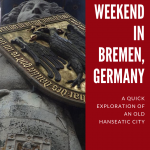
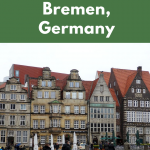
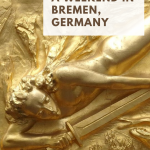
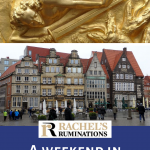

I love all the buildings in your photos. Bremen looks a great place to visit and wander around. Lots of charm.
It is!
Hello Rachel, not sure if I have mentioned this in your blog but my German ancestor was from Bremen (or from the area), so, I have always had the desire to visit Northern Germany to find more about my roots. I am glad the city looks so great. Gives me more impulse to plan a trip to the area.
Let me know when you’re headed this way! The landscape around here, and between here and Bremen, is FLAT. Fields, farms, villages, the occasional windmill or canal. That’s about it!
I just love the towns of Germany — at least the ones I’ve visited so far and judging by your post I’m pretty sure I’d love Bremen. I was actually in Bremen very briefly, just to make a train change. Wish I’d planned better and stayed.
Bremen doesn’t have as much to see as cities like Berlin or Koln, but it’s worth a day or two!
I know what you mean about leaving teenagers at home. It was a great idea to be close on the first occasion – you will feel more comfortable from now on. Bremen looked like a good choice and it is nice not to have to travel very far for a couple of days. It sounds like an interesting place with the zigzags and 15th century houses turned shops.
I wasn’t really worried about the kids. They’re all good kids. And the worst that happened was a messy kitchen! (Teenagers eat A LOT!)
I hope to visit Europe some day & it’s good to read about some of the “lesser-known” places like Bremen.
And as for “teens” alone…I always think of those impromptu Facebook “parties” that you get to read about in the papers the next day- lol.
Haha, I know! Though none of them is the type to do that. A few years ago in our next-door town, one party got so out of hand that it made international news! That happened because the girl whose birthday it was set the event on Facebook to public and shareable rather than private. Thousands showed up! That may be the party you read about…
This is a lovely post Rachel!
Bremen is a very nice historical town with (in my opinion) an English feel but then again, i say the same thing about Heidelberg which reminds me of York lol!
I think a weekend is fine as Bremen is such a small place. However, my German in-laws live about 30 mins away in a town called Achim and Oyten. If you have a few more days, I would recommend them for the valleys, fields, lakes and horse-riding!
Thanks for the recommendation!
This time your teens were nice and obedient to get your trust and next time they’ll have a great party 😉 #TPThursday
That hadn’t occurred to me … :/